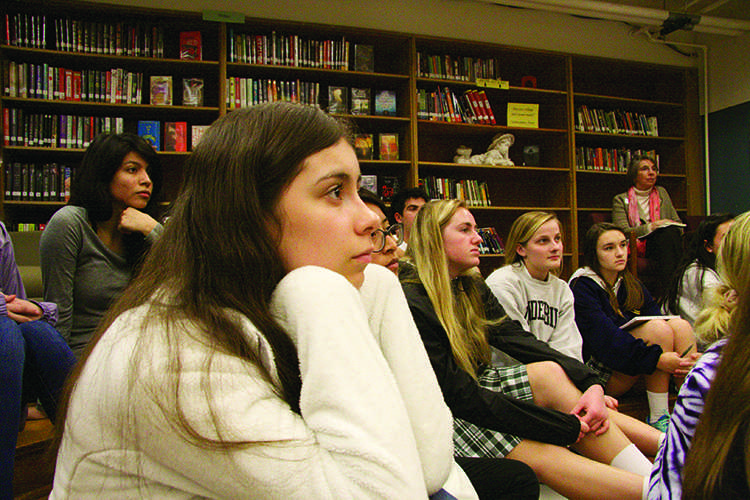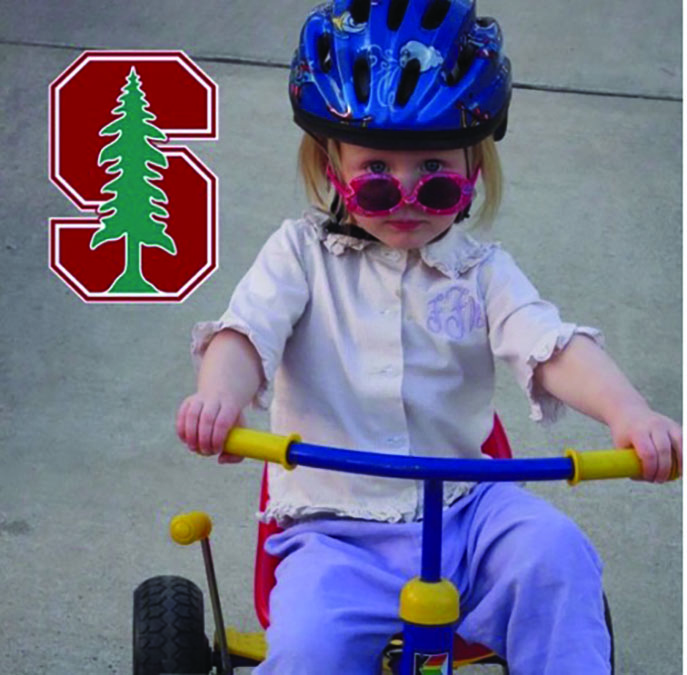PICTURED ABOVE: Students from Thomas Jefferson High School and Hockaday listen to actor Chris Ramirez as he speaks to them at TJ on Jan. 31. Ramirez talked to the students about his decision to become an actor. The students then saw the play “Sweat” together on Feb. 6 after having read the book.
On Jan. 31, the B period Contemporary American Literature class began what would shape out to be an unordinary week. Students from Hockaday and Thomas Jefferson High School met and discussed controversial racial and socioeconomic topics in Lynn Nottage’s Pulitzer Prize-winning play “Sweat,” collaborating for a new class experience.
In her classroom, Hockaday English Department Chair Janet Bilhartz often experiments with the connections between literature and life. She believes that it has the power to open up stories and wanted to apply that power to real life.
“I always loved books, so for me, it’s always about literature and how it speaks to our lives,” Bilhartz said.
Laura Day, the Founding Executive Director of the Institute for Social Impact, also strives towards greater class involvement in real life scenarios. She found that Bilhartz had a similar goal of connecting literature and reality, so the two decided to collaborate in the classroom. “We are looking at not only doing service in the world, but also how can we partner and learn from other people, and really just improve the world together,” Day said.
It was a pure coincidence as to how Bilhartz discovered the play; she inadvertently saw “Sweat” at a Broadway show and immediately fell in love—calling it a “serendipitous event”— with the storyline and the sentimental emotions Nottage elicits through the conflicts she creates.
“For my Contemporary [American] Literature class, I always choose a play that is presented at a theater in town,” Bilhartz said. “I love this play, and about a year ago when it first came out, I was looking to see what will Dallas Theater Center be putting on next year, and I saw, ‘They’re putting on “Sweat!” Fabulous!’”
Day observed that although Thomas Jefferson High School is located approximately three miles away from Hockaday, not many interactions had taken place between the two schools. Thus, she contacted Tyler Smith, AP English teacher at TJ High School, and consulted him about the project. Smith showed interest, and all three teachers met and planned further details last spring.
“Thomas Jefferson is another really close high school, and we weren’t doing anything with Thomas Jefferson,” Day said.
Each class from the two different schools read the play separately, then both Hockaday and TJ met on Jan. 29 and 31 to discuss complex questions regarding relationships, race and socioeconomic differences. On Jan. 31, Chris Ramirez, an actor who plays a character in the play, led a workshop about the behind- the-scenes process of “Sweat.” After the discussion, they visited the Dallas Theater Center on Feb. 6 to watch the play and have a workshop that included a simulation about labor, strikes and American Dream—one of the key themes of “Sweat.”
Hockaday senior Jessica Katzman found the discussions eye-opening. Although some of the play’s themes are controversial, she believes they must be openly discussed.
“The more opinions you hear, the more perspectives you hear, the more informed opinions you create. It’s important to hearing everything and being exposed from everything from everyone in all situations, [but] that’s really hard to do because often time it’s hard to imagine a situation you don’t live in,” Katzman said.
Collaboration between the two high schools represent the interaction of two distinctly different communities and institutes a safe space to share differing perspectives. TJ High School is a public secondary school in the Dallas Independent School District, and Hockaday is a private school. While Hockaday’s student body consists mainly of Caucasians, Hispanics—many of whom are recent immigrants— dominate TJ’s student population. According to Day, 98 percent of the students are subject to free and reduced lunch and fall below the poverty line, whereas Niche reports that 16 percent of Hockaday students receive financial aid. The natures of the schools sharply differ, but Day and Bilhartz believe that this experience will be mutually beneficial for both schools.
Smith, Day and Bilhartz all agree that “Sweat” discusses a very controversial subject that is still relevant today.
“[The play] highlights the breakdown of social bonds and relationships as a result of some of the changes the economy is going through, and it highlights some of the reasons of the rise in racial tensions,” Smith said. “I think that these are pretty difficult political topics to discuss honestly and openly, and I think putting it in a framework of piece of literature opens up potential conversations on these tough topics.”
All three teachers emphasized the importance of conversation between public-private school interactions. According to Smith, TJ also “tends to fall into a bubble” of the significant ethnic and socioeconomic segregation in Dallas.
“What happens a lot is that a lot of the students here don’t know anyone who goes to school down the street,” Day said. “And that’s crazy. We have so much to learn from each other, and we can learn so much from them, and they can learn so much from us.”
Nottage, the playwright, intended to create more dialogue regarding racial and socioeconomic polarization and its ramifications through her play. Reflecting upon her intentions, the two schools created a forum for discourse, despite their differences.
“My real hope is that after the audience sees the play, that they want to sit down and talk to someone who they’ve never had a conversation with before,” Nottage said. “I hope that they will ask really tough conversations not just of themselves, but of the legislators and the people who are in power.”
The teachers aspire to initiate more private-public school interactions, especially in times of polarization across the States, through similar future opportunities. Smith hopes that through such opportunities, students will bring change to the culture of segregation in Dallas and also have greater interest in current events.
“It’s not anyone’s choice that we are segregated, [but] it’s just that you are never in the same stuff unless people bring you together,” Day said. “I think it’s so powerful for people to learn each other’s stories. But the more people’s stories you can learn, the better we are as human beings.”
Bilhartz believes that it is necessary to step out of the comfort zone and address issues around us with different perspectives. With communication, people from diverse backgrounds could find a common solution to a seemingly difficult problem.
“And how is the United States going to prosper, going forward as a country, if we can’t talk across those socioeconomic and racial lines?” Bilhartz said. “How are we going to work towards that common goal even though we come from different places?”
Story by Eugene Seong, People Editor
Photo by Michelle Chen








